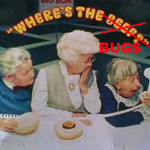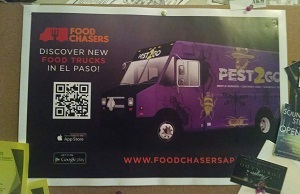 The status of the edible insect movement is questioned by just about every foodie who remembers sticky fondue and sickly sweet Snackwells: Are bugs just another food fad? Of course my overly zealous answer is NO, the entomophagy movement is neither fad nor trend, but an edible revolution on the verge of fundamentally shifting the Western protein pallet in a more sustainable direction. Everyone in the edible insect industry, myself included, is very very passionate about what we’re doing. Such zeal makes holding an objective view of the movement tricky; are edible insects just a fad, a promising trend, or seriously on their way to becoming a mainstay?
The status of the edible insect movement is questioned by just about every foodie who remembers sticky fondue and sickly sweet Snackwells: Are bugs just another food fad? Of course my overly zealous answer is NO, the entomophagy movement is neither fad nor trend, but an edible revolution on the verge of fundamentally shifting the Western protein pallet in a more sustainable direction. Everyone in the edible insect industry, myself included, is very very passionate about what we’re doing. Such zeal makes holding an objective view of the movement tricky; are edible insects just a fad, a promising trend, or seriously on their way to becoming a mainstay?
Fad v. Trend
First of all, what’s the difference between a food fad and a food trend? In general, a food fad begins as a innovative or uncommon food, cooking technique, or niche that gains notoriety via any number of drivers, especially the world wide blogosphere. Once a food fad moves beyond sheer hype and makes its way onto the shelves of Wholefoods and eventually Walmart, the fad has arrived as a trend. A trend needs to be a tangible thing.
Edible Insect Industrial Complex
New foods must evolve; they thrive, adapt, or die. Where is the edible insect movement in this process? A quick sampling of the Google machine reveals a whopping 139,000 search results for ‘entomophagy,’ 751,000 results for ‘edible insect,’ and 1,120,000 for ‘insect recipe.’ Its clear that edible insects have the hype to be a fad, but do they have the momentum to become a trend? The multitudes of news articles about edible insects are stemming from increasingly noteworthy sources like Forbes, ABC, and The Economist which all extol the promise and potential of the edible insect movement. The merits of this praise in part rests on the backs of the many ento-preneurs who have birthed a multimillion dollar ‘Edible Insect Industrial Complex.’ Several years ago entomophagaists in the US had only pet stores and home rearing to turn, today Chapul and Exo bars on the shelves of Wholefoods and many edible insect products can be purchased online. Quality farm-raised edible insects are becoming more and more accessible, sales are increasing, and repeat customers are forming. The quick rise of this industry driven by several years of media hype and decades of academic interest has finally fueled a full blown edible insect food trend.
Trend Drivers
 Edible insects as a real Western food trend has surpassed the expectations of many squeamish cynics, however, the battle is far from won. I recently had the pleasure of reading The Tastemakers by David Sax to better understand the nature of food trends; why do some trends persist while others never move beyond the test kitchen? More often than not, the primary driver of success was what you’d expect, a clever marketing marketing campaign for scaleable food product. Bacon is a good example of such a product; excesses of inexpensive pork bellies combined with a well funded marketing strategy created the grotesque worship of this piggy product evident in products like bacon mayo and bacon milkshakes. In addition to well funded ad campaigns, sex and celebrity are tested drivers of food trends; the cupcake craze which has swept the US and generated a quarter of a billion dollar industry is primarily accredited to a singular mention on Sex and the City TV show over a decade ago.
Edible insects as a real Western food trend has surpassed the expectations of many squeamish cynics, however, the battle is far from won. I recently had the pleasure of reading The Tastemakers by David Sax to better understand the nature of food trends; why do some trends persist while others never move beyond the test kitchen? More often than not, the primary driver of success was what you’d expect, a clever marketing marketing campaign for scaleable food product. Bacon is a good example of such a product; excesses of inexpensive pork bellies combined with a well funded marketing strategy created the grotesque worship of this piggy product evident in products like bacon mayo and bacon milkshakes. In addition to well funded ad campaigns, sex and celebrity are tested drivers of food trends; the cupcake craze which has swept the US and generated a quarter of a billion dollar industry is primarily accredited to a singular mention on Sex and the City TV show over a decade ago.
Moving the Ento Trend Forward
So what lessons can the burgeoning edible insect industry learn form trends past? Cohesive marketing. Ento-preneurs need to learn from the pork industry. We need an insect growers association that collectively funds edible insect marketing, research, and lobbying. An organized cohesive voice will not only put edible insects on american plates, but ensure that this food trend endures.
Update: As further proof that edible insects are here to stay, check out the Baum Whitman 2015 food trend predictions: http://www.baumwhiteman.com/2015Trends.pdf
“The conversation about eating bugs is just beginning but it won’t go away.”